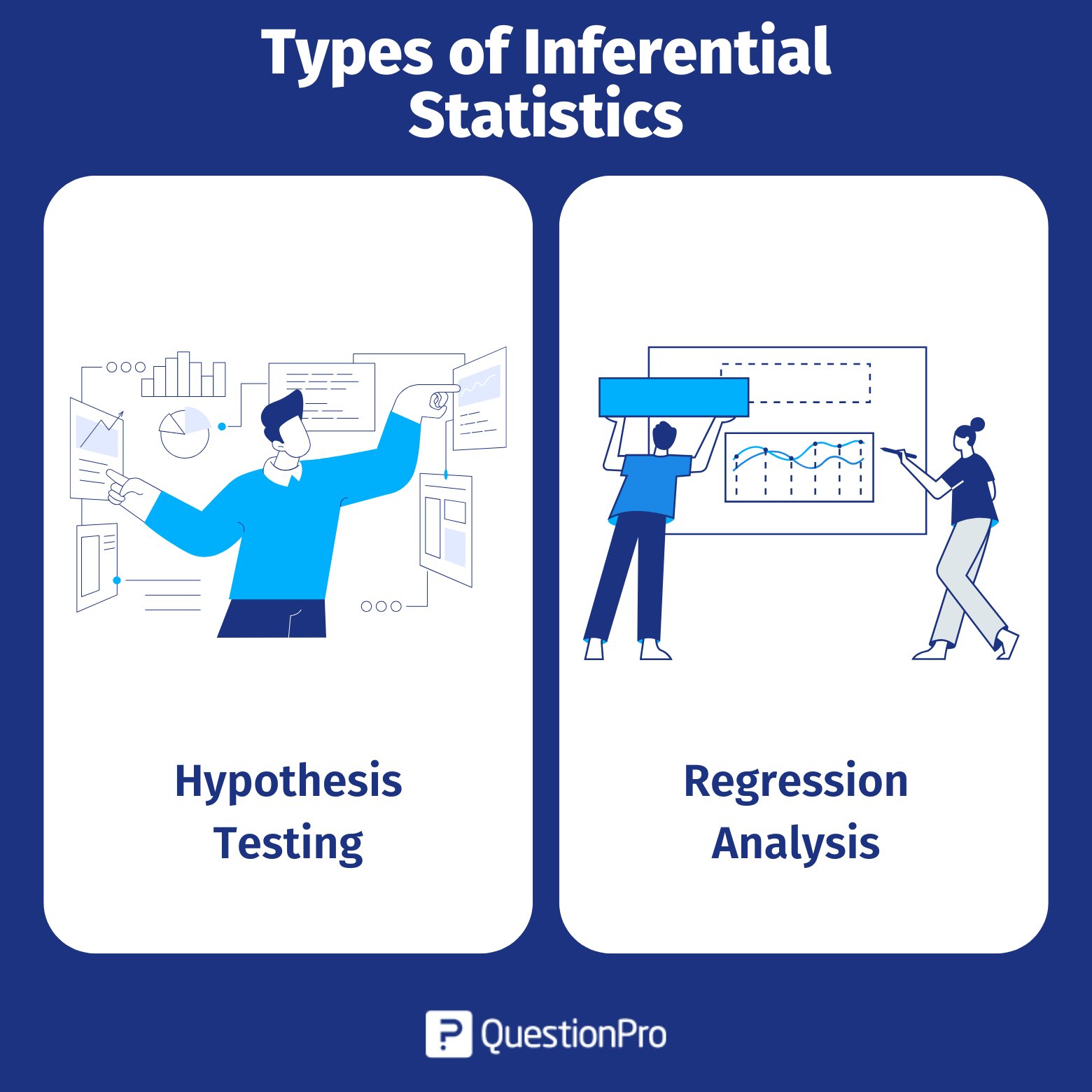
If you are a student in a statistics class or a professional researcher, you need to know how to use inferential statistics to analyze data and make smart decisions. In this age of “big data,” when we have access to a lot of information, the capacity to draw correct population conclusions from samples is crucial.
Inferential statistics enable you to draw inferences and make predictions based on your data, whereas descriptive statistics summarize the properties of a data collection. It is an area of mathematics that enables us to identify trends and patterns in a large number of numerical data.
In this post, we will discuss inferential statistics, including what they are, how they work, and some examples.
Definition of Inferential Statistics
Inferential statistics uses statistical techniques to extrapolate information from a smaller sample to make predictions and draw conclusions about a larger population.
It uses probability theory and statistical models to estimate population parameters and test population hypotheses based on sample data. The main goal of inferential statistics is to provide information about the whole population using sample data to make the conclusions drawn as accurate and reliable as possible.
There are two primary uses for inferential statistics:
- Providing population estimations.
- Testing theories to make conclusions about populations.
Researchers can generalize a population by utilizing inferential statistics and a representative sample. It requires logical reasoning to reach conclusions. The following is a procedure of the method for arriving at the results:
- The population to be investigated should be chosen as a sample. The sample should reflect the population’s nature and characteristics.
- Inferential statistical techniques are used to analyze the sample’s behavior. These include the models used for regression analysis and hypothesis testing.
- The first-step sample is used to draw conclusions. Inferences are drawn using assumptions or predictions about the entire population.
Types of Inferential Statistics
Inferential statistics are divided into two categories:
- Hypothesis testing.
- Regression analysis.
Researchers frequently employ these methods to generalize results to larger populations based on small samples. Let’s look at some of the methods available in inferential statistics.
01. Hypothesis testing
Testing hypotheses and drawing generalizations about the population from the sample data are examples of inferential statistics. Creating a null hypothesis and an alternative hypothesis, then performing a statistical test of significance are required.
A hypothesis test can have left-, right-, or two-tailed distributions. The test statistic’s value, the critical value, and the confidence intervals are used to conclude. Below are a few significant hypothesis tests that are employed in inferential statistics.
Z Test
When data has a normal distribution and a sample size of at least 30, the z test is applied to the data. When the population variance is known, it determines if the sample and population means are equal. The following setup can be used to test the right-tailed hypothesis:
Null Hypothesis: H0: μ=μ0
Alternate hypothesis: H1: μ>μ0
Test Statistic: Z Test = (x̄ – μ) / (σ / √n)
where,
x̄ = sample mean
μ = population mean
σ = standard deviation of the population
n = sample size
Decision Criteria: If the z statistic > z critical value, reject the null hypothesis.
T Test
When the sample size is less than 30, and the data has a student t distribution, a t test is utilized. The sample and population mean are compared when the population variance is unknown. The inferential statistics hypothesis test is as follows:
Null Hypothesis: H0: μ=μ0
Alternate Hypothesis: H1: μ>μ0
Test Statistic: t = x̄−μ / s√n
The representations x̄, μ, and n are the same as stated for the z-test. The letter “s” represents the standard deviation of the sample.
Decision Criteria: If the t statistic > t critical value, reject the null hypothesis.
F Test
When comparing the variances of two samples or populations, an f test is used to see if there is a difference. The right-tailed f test can be configured as follows:
Null Hypothesis: H0 :σ21 =σ22
Alternate Hypothesis: H1 :σ21> σ22
Test Statistic: f = σ21 / σ22, where σ21 is the variance of the first population, and σ22 is the variance of the second population.
Decision Criteria: Deciding Criteria: Reject the null hypothesis if f test statistic > critical value.
A confidence interval aids in estimating a population’s parameters. For instance, a 95% confidence interval means that 95 out of 100 tests with fresh samples performed under identical conditions will result in the estimate falling within the specified range. A confidence interval formula can also be used to determine the crucial value in hypothesis testing.
In addition to these tests, inferential statistics also use the ANOVA, Wilcoxon signed-rank, Mann-Whitney U, Kruskal-Wallis, and H tests.
LEARN ABOUT: ANOVA testing

02. Regression analysis
Regression analysis calculates how one variable will change to another. Numerous regression models can be used, including simple linear, multiple linear, nominal, logistic, and ordinal regression.
In inferential statistics, linear regression is the most often employed type of regression. The dependent variable’s response to a unit change in the independent variable is examined through linear regression. These are a few crucial equations for regression analysis using inferential statistics:
Regression Coefficients:
The straight line equation is given as y = α + βx, where α and β are regression coefficients.
β=∑n1(xi − x̄)(yi −y) / ∑n1(xi−x)2
β=rxy σy / σx
α=y−βx
Here, x is the mean, and σx is the standard deviation of the first data set. Similarly, y is the mean, and σy is the standard deviation of the second data set.
Example of inferential statistics
Consider for this example that you based your research on the test results for a particular class as described in the descriptive statistics section. You now want to do an inferential statistics study for that same test.
Assume it is a standardized statewide exam. You may demonstrate how this alters how we perform the study and the results you report by using the same test, but this time to draw inferences about a community.
Choose the class you wish to describe in descriptive statistics, and then enter all the test results for that class. Good and easy. You must first define the population for inferential statistics before selecting a random sample from it.
To ensure a representative sample, you must develop a random sampling strategy. This procedure may take time. Let’s use fifth-graders attending public schools in the U.S. state of California as your population definition.
For this example, assume that you gave the entire population a list of names, then selected 100 students randomly from that list and obtained their test results. Be aware that these students will not be from a single class but rather a variety of classes from various schools throughout the state.
Inferential statistics results in
The mean, standard deviation, and proportion for your random sample can all be calculated using inferential statistics as a point estimate. There is no way to know, but it is unlikely that any of these point estimations are exact. These figures have a margin of error because measuring every subject in this population is impossible.
Include the confidence intervals for the mean, standard deviation, and percentage of satisfactory scores (>=70). The CSV data file contains inferential statistics.
| Statistic | Population Parameter Estimates (CIs) |
| Mean | 77.4 – 80.9 |
| Standard deviation | 7.7 – 10.1 |
| Proportion scores >= 70 | 77% – 92% |
The population mean is between 77.4 and 80.9, with a 95% confidence interval given the uncertainty around these estimates. A measure of dispersion, the population standard deviation is most likely to range between 7.7 and 10.1. Moreover, between 77% and 92% is predicted for the population’s proportion of satisfactory scores.
Differences between Descriptive and Inferential Statistics
Both descriptive and inferential statistics are types of statistical analysis used to describe and analyze data. Here are the main differences between them:
Definition
Descriptive statistics use measures like mean, median, mode, standard deviation, variance, and range to summarize and describe a data set’s characteristics. They don’t make conclusions or predictions about a population based on the data.
Inferential statistics, on the other hand, use a sample of data to draw conclusions about the population from which the data came. They use probability theory and statistical models to determine the likelihood of certain outcomes and test hypotheses about the population.
Purpose
Descriptive statistics are usually used to summarize the data and explain the most important parts of the dataset clearly and concisely. They describe a variable’s distribution, find trends and patterns, and examine the relationship between variables.
Inferential statistics are usually used to test hypotheses and draw conclusions about a population from a sample. They are used to make predictions, estimate parameters, and test the importance of differences between groups.
Data
Descriptive statistics can be used on any type of data, including numerical data (like age, weight, and height) and categorical data (e.g. gender, race, occupation).
Inferential statistics use random samples from a population and make assumptions about how the data are distributed and how big the sample is.
Results
Descriptive statistics give an overview of the data and are usually shown in tables, graphs, or summary statistics.
Inferential statistics give estimates and probabilities about a population and are usually reported as hypothesis tests, confidence intervals, and effect sizes.
While inferential statistics are used to make inferences about the population based on sample data, descriptive statistics are used to summarize and characterize the data.
The Importance of Inferential Statistics: Some Remarks
- Inferential statistics uses analytical tools to determine what a sample’s data says about the whole population.
- Inferential statistics include things like testing a hypothesis and looking at how things change over time.
- Inferential statistics use sampling methods to find samples that are representative of the whole population.
- Inferential statistics uses tools like the Z test, the t-test, and linear regression to determine what is happening.
Conclusion
Inferential statistics is a powerful way to draw conclusions about whole groups of people based on data from a small sample. Inferential statistics uses probability sampling theory and statistical models to help researchers determine certain outcomes’ likelihood and test their ideas about the population. In statistical analysis, distinguishing between categorical data and numerical data is essential, as categorical data involves distinct categories or labels, while numerical data consists of measurable quantities.
Inferential statistics is an important part of the data unit of analysis and research because it lets us make predictions and draw conclusions about whole populations based on data from a small sample. It is a complicated and advanced field that requires careful thought about assumptions and data quality, but it can give important research questions and answers to important questions.
QuestionPro gives researchers an easy and effective way to collect and analyze data for inferential statistics. Its sampling options let you create a sample population representative of the larger population, and its data-cleaning tools help ensure the data is accurate.
QuestionPro is a helpful tool for researchers who need to collect and analyze data for inferential statistics. QuestionPro’s analytical features let you examine the relationships between variables, estimate population parameters, and test hypotheses. So sign up now!







